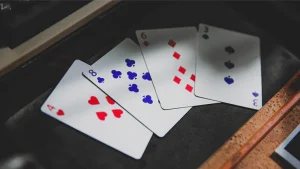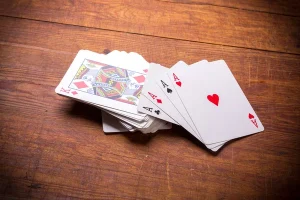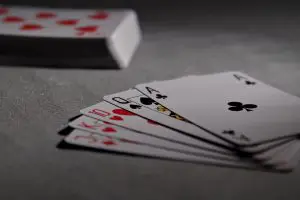Playing cards have been a source of entertainment and competition for centuries, gracing the tables of casual card games and high-stakes poker matches alike. Yet, have you ever wondered about the precise dimensions of these iconic pieces of cardstock? “What size is a playing card?” is a question that may seem simple, but the answer reveals the careful consideration and standards that have shaped the world of playing cards.
In this article, we will delve into the standard dimensions of a playing card, shedding light on the exact size that has become a familiar sight in games and magic tricks around the globe.
What size is a standard playing card?

The standard size of a playing card is 2.5 inches by 3.5 inches (64mm x 89mm). This size is also known as poker-sized or wide cards. It is the most popular size of playing cards and is used for most card games, including poker, blackjack, and solitaire.
There are other sizes of playing cards available, such as bridge-sized (2.25 inches by 3.5 inches) and miniature (1.8 inches by 1.3 inches). Bridge-sized cards are narrower than poker-sized cards and are often used for games like bridge and whist. Miniature cards are smaller and are often used for children’s games or for card tricks.
The thickness of a standard playing card is typically between 0.17 mm and 0.24 mm. The thickness of the card can affect its durability and flexibility.
What are the dimensions of a typical playing card?
The dimensions of a typical playing card are 2.5 inches by 3.5 inches (64mm x 89mm). This is the standard size for playing cards used in most games, such as poker, blackjack, and bridge. The cards are also typically 0.17 mm to 0.24 mm thick.
There are two other standard sizes for playing cards: bridge size and tarot size. Bridge-sized cards are slightly smaller than poker-sized cards, measuring 2.25 inches by 3.5 inches (57mm x 89mm). Tarot-sized cards are larger than poker-sized cards, measuring 2.75 inches by 4.75 inches (70mm x 121mm).
The size of a playing card can affect the way it is played. For example, bridge-sized cards are easier to hold and manipulate than poker-sized cards, which makes them a popular choice for card games that involve a lot of hand movement, such as bridge and contract bridge. Tarot-sized cards are often used for games that require a lot of space, such as tarot card reading.
Ultimately, the best size of playing card for a particular game is a matter of personal preference. Some people prefer the larger size of tarot cards, while others prefer the smaller size of bridge-sized cards. The standard size of poker-sized cards is a good compromise between size and ease of use.
How large is a regular playing card?
A regular playing card is typically 2.5 inches by 3.5 inches (64mm x 89mm). This is the standard size for playing cards used in most games, such as poker, blackjack, and bridge. The cards are also typically 0.17 mm to 0.24 mm thick.
The size of a playing card can affect the way it is played. For example, bridge-sized cards are slightly smaller than poker-sized cards, measuring 2.25 inches by 3.5 inches (57mm x 89mm). Tarot-sized cards are larger than poker-sized cards, measuring 2.75 inches by 4.75 inches (70mm x 121mm).
The standard size of poker-sized cards is a good compromise between size and ease of use. They are large enough to be easily seen and manipulated, but not so large that they are cumbersome.
Here are some other sizes of playing cards:
- Bridge-sized cards: 2.25 inches by 3.5 inches (57mm x 89mm)
- Tarot-sized cards: 2.75 inches by 4.75 inches (70mm x 121mm)
- Miniature playing cards: 1.8 inches by 1.3 inches (45mm x 32mm)
- Jumbo playing cards: 3.75 inches by 5 inches (95mm x 127mm)
The size of the playing cards can also vary depending on the manufacturer and the type of game they are designed for. For example, some manufacturers make playing cards that are specifically designed for children, which are often smaller and thinner than standard playing cards.
Ultimately, the best size of playing card for a particular game is a matter of personal preference. Some people prefer the larger size of tarot cards, while others prefer the smaller size of bridge-sized cards. The standard size of poker-sized cards is a good compromise between size and ease of use.
What dimensions are common for playing cards?

Common playing cards come in two primary sizes: poker size and bridge size.
- Poker Size:
- Width: Approximately 2.5 inches (6.35 cm)
- Height: Approximately 3.5 inches (8.89 cm)
Poker size cards are the most popular and widely used playing cards for various card games, casinos, and home use. They are slightly larger than bridge size cards and provide more space for artwork, suits, and card values. Poker size cards are often used for games like Texas Hold’em and blackjack.
- Bridge Size:
- Width: Approximately 2.25 inches (5.72 cm)
- Height: Approximately 3.5 inches (8.89 cm)
Bridge size cards are slightly narrower than poker size cards. They are primarily used for the game of bridge and are also preferred by some people for other card games where holding and managing a smaller hand of cards is more comfortable. Bridge size cards can be easier to handle for individuals with smaller hands.
These two sizes are the most common and readily available, but there are other non-standard sizes and shapes used for specialty decks, collectible cards, and novelty playing cards. However, for standard card games and most practical purposes, poker size and bridge size cards are the norm.
Top of Form
How big is a traditional playing card?
The most popular size of a traditional playing card is 2.5 inches by 3.5 inches (6.4 cm by 8.9 cm). This is also known as the “poker size”. It is the standard size for playing poker, bridge, and other card games.
There are also other sizes of playing cards available, such as:
- Bridge size: 2.5 inches by 2.25 inches (6.4 cm by 5.7 cm)
- Pinochle size: 2.75 inches by 3.5 inches (7.0 cm by 8.9 cm)
- Miniature size: 1.65 inches by 2.5 inches (4.2 cm by 6.4 cm)
- Jumbo size: 3.75 inches by 5 inches (9.5 cm by 12.7 cm)
The size of a playing card can also vary depending on the manufacturer and the game it is intended for. For example, tarot cards are typically larger than poker cards.
Ultimately, the best size of playing card for you will depend on your personal preferences and the games you plan to play.
What are the dimensions of a standard playing card deck?
The standard dimensions of a playing card deck are 2.5 inches by 3.5 inches (64 mm by 89 mm). This is also known as the “poker size”. It is the most common size of playing card deck and is used for most card games, such as poker, bridge, and blackjack.
The thickness of a playing card deck can vary depending on the manufacturer and the quality of the cards. However, most playing card decks are between 0.17 mm and 0.24 mm thick.
The weight of a playing card deck can also vary, but most decks weigh between 280 grams and 310 grams.
It is important to note that the dimensions of a playing card deck can vary slightly from manufacturer to manufacturer. However, the standard dimensions of 2.5 inches by 3.5 inches are generally accepted as the standard size for playing cards.
What’s the average size of a playing card in centimeters?

The average size of a playing card in centimeters is approximately 6.35 cm in width and 8.89 cm in height. These measurements correspond to the dimensions of a standard poker size playing card, which is the most common and widely used size for playing cards.
To provide a more detailed explanation:
- Width: Approximately 6.35 cm (or 63.5 millimeters): This is the measurement from the left edge to the right edge of the card when it’s held horizontally. It’s the dimension that determines how wide the card is.
- Height: Approximately 8.89 cm (or 88.9 millimeters): This is the measurement from the top edge to the bottom edge of the card when it’s held vertically. It’s the dimension that determines how tall the card is.
These dimensions are standardized for poker size playing cards, which are used in a wide range of card games and other card-related activities.
However, it’s worth noting that while these measurements are typical, there can be slight variations in card sizes depending on the manufacturer or the specific design of the cards. Nevertheless, poker size remains the most common and recognizable size for playing cards.
Conclusion
You can find all you need to know on how much is a pound of pennies worth on this page. A pound of pennies is worth $1. In the United States, there are 100 pennies in a dollar, so when you have a pound (16 ounces) of pennies, you have the equivalent of $1 in value.


